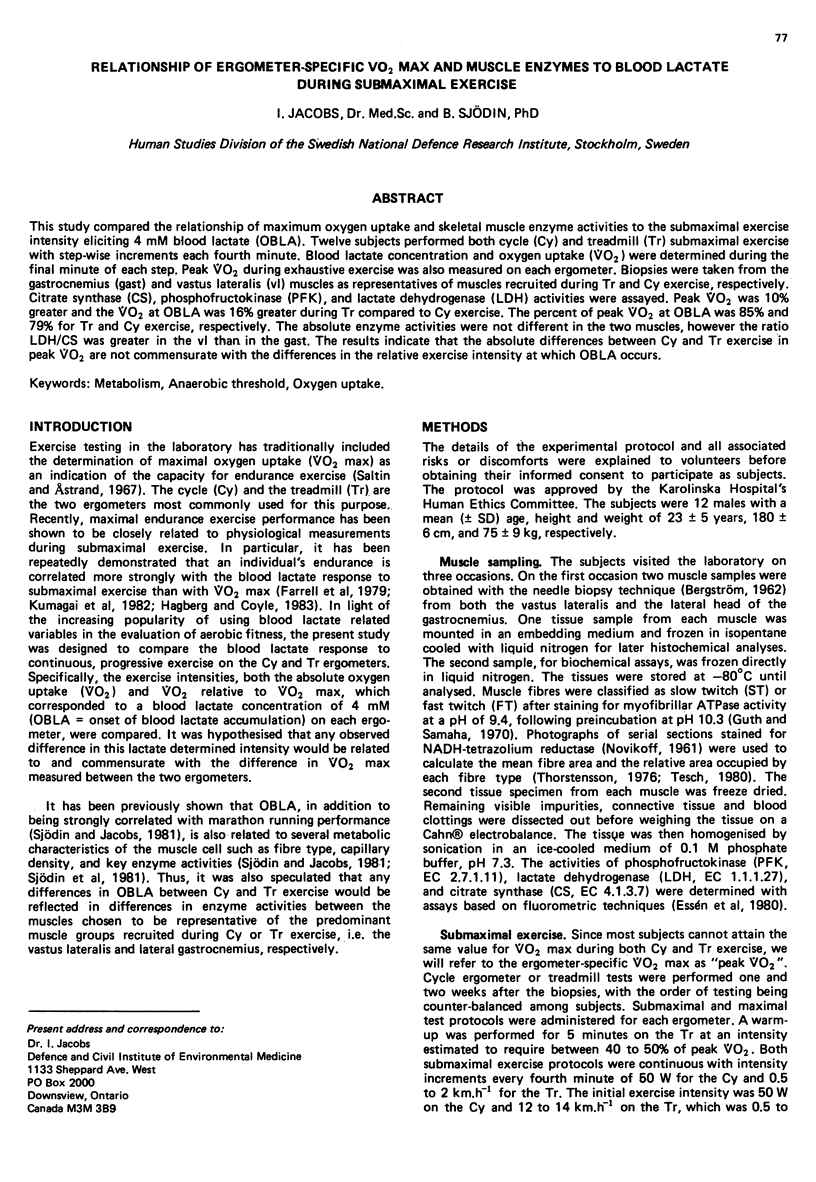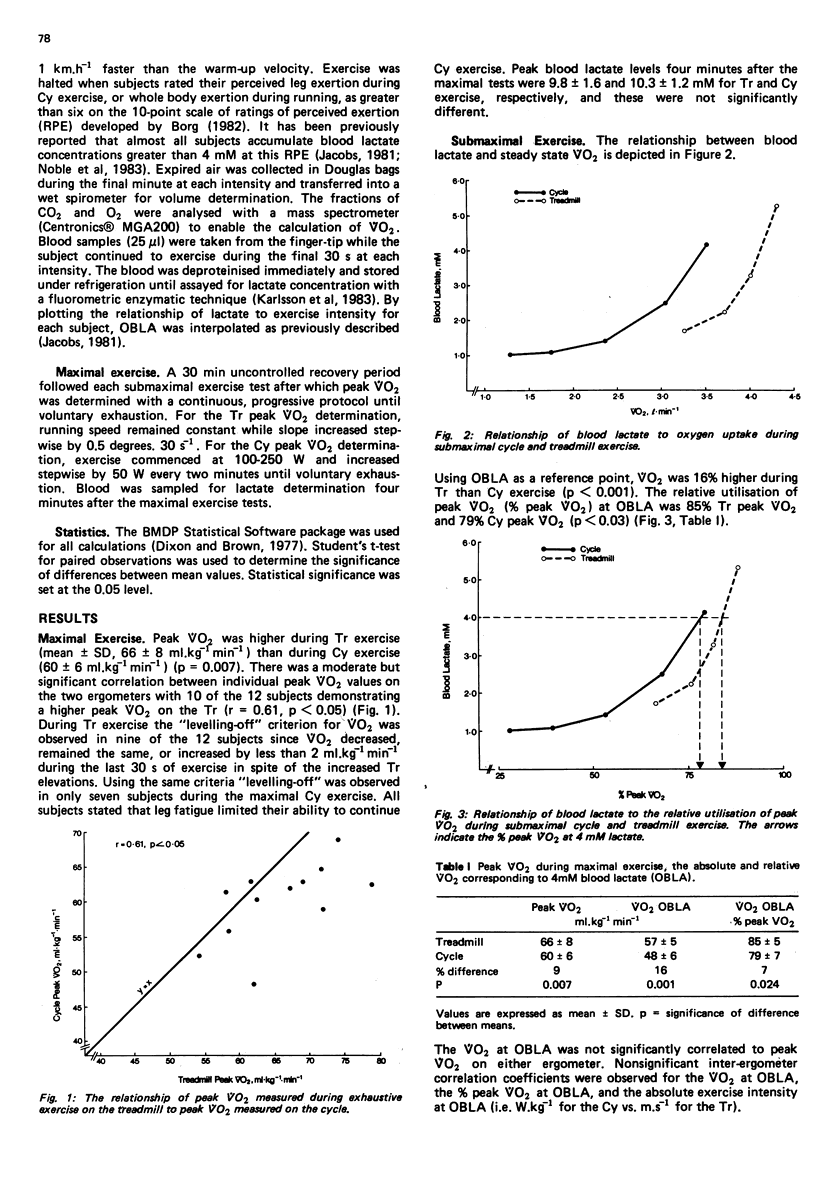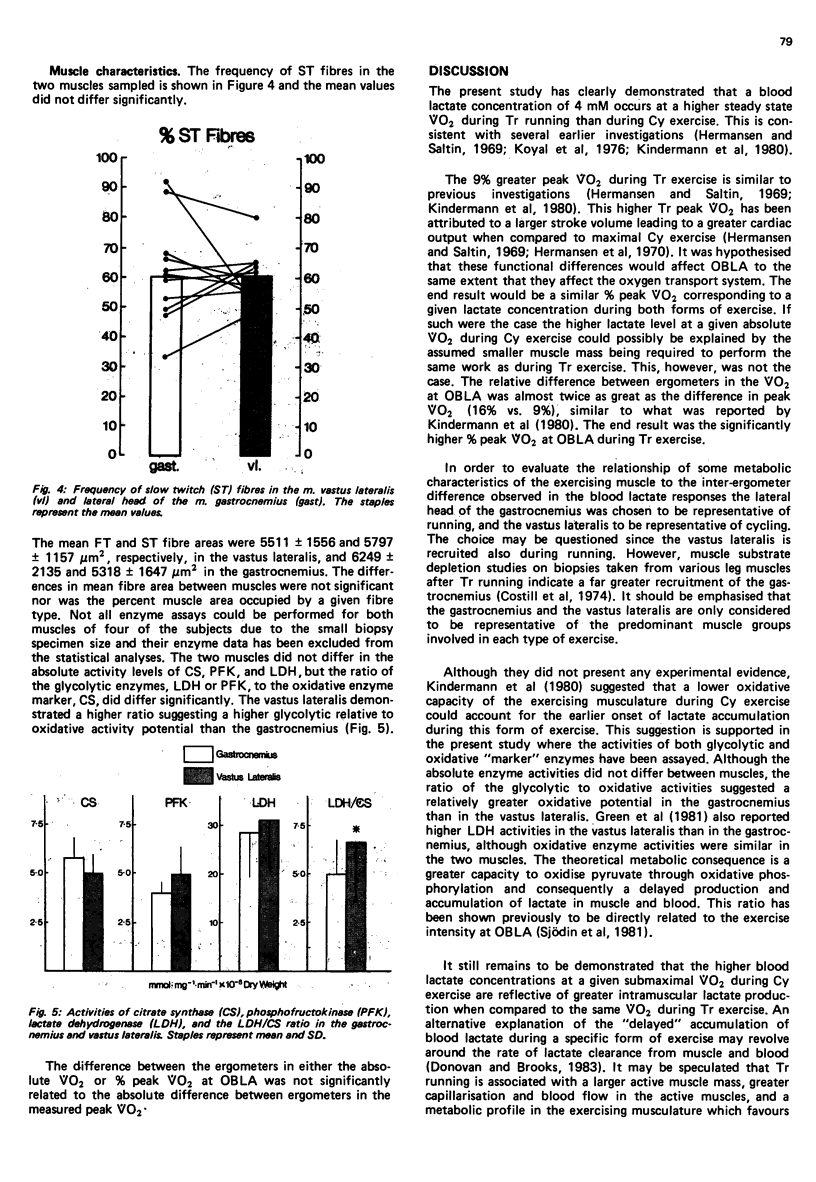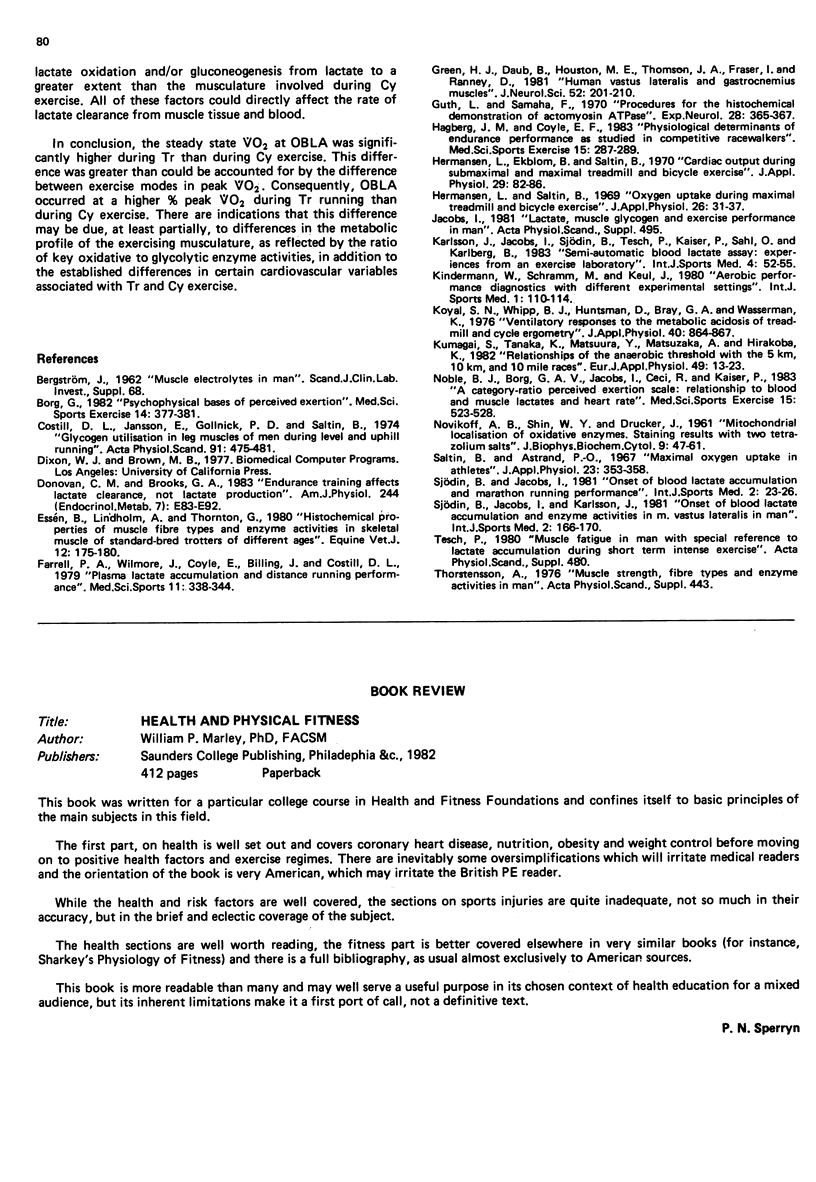Abstract
This study compared the relationship of maximum oxygen uptake and skeletal muscle enzyme activities to the submaximal exercise intensity eliciting 4 mM blood lactate (OBLA). Twelve subjects performed both cycle (Cy) and treadmill (Tr) submaximal exercise with step-wise increments each fourth minute. Blood lactate concentration and oxygen uptake (VO2) were determined during the final minute of each step. Peak VO2 during exhaustive exercise was also measured on each ergometer. Biopsies were taken from the gastrocnemius (gast) and vastus lateralis (vl) muscles as representatives of muscles recruited during Tr and Cy exercise, respectively. Citrate synthase (CS), phosphofructokinase (PFK), and lactate dehydrogenase (LDH) activities were assayed. Peak VO2 was 10% greater and the VO2 at OBLA was 16% greater during Tr compared to Cy exercise. The percent of peak VO2 at OBLA was 85% and 79% for Tr and Cy exercise, respectively. The absolute enzyme activities were not different in the two muscles, however the ratio LDH/CS was greater in the vl than in the gast. The results indicate that the absolute differences between Cy and Tr exercise in peak VO2 are not commensurate with the differences in the relative exercise intensity at which OBLA occurs.
Full text
PDF



Selected References
These references are in PubMed. This may not be the complete list of references from this article.
- Borg G. A. Psychophysical bases of perceived exertion. Med Sci Sports Exerc. 1982;14(5):377–381. [PubMed] [Google Scholar]
- Costill D. L., Jansson E., Gollnick P. D., Saltin B. Glycogen utilization in leg muscles of men during level and uphill running. Acta Physiol Scand. 1974 Aug;91(4):475–481. doi: 10.1111/j.1748-1716.1974.tb05703.x. [DOI] [PubMed] [Google Scholar]
- Donovan C. M., Brooks G. A. Endurance training affects lactate clearance, not lactate production. Am J Physiol. 1983 Jan;244(1):E83–E92. doi: 10.1152/ajpendo.1983.244.1.E83. [DOI] [PubMed] [Google Scholar]
- Essén B., Lindholm A., Thornton J. Histochemical properties of muscle fibres types and enzyme activities in skeletal muscles of Standardbred trotters of different ages. Equine Vet J. 1980 Oct;12(4):175–180. doi: 10.1111/j.2042-3306.1980.tb03420.x. [DOI] [PubMed] [Google Scholar]
- Farrell P. A., Wilmore J. H., Coyle E. F., Billing J. E., Costill D. L. Plasma lactate accumulation and distance running performance. Med Sci Sports. 1979 Winter;11(4):338–344. [PubMed] [Google Scholar]
- Green H. J., Daub B., Houston M. E., Thomson J. A., Fraser I., Ranney D. Human vastus lateralis and gastrocnemius muscles. A comparative histochemical and biochemical analysis. J Neurol Sci. 1981 Nov-Dec;52(2-3):201–210. doi: 10.1016/0022-510x(81)90005-8. [DOI] [PubMed] [Google Scholar]
- Guth L., Samaha F. J. Procedure for the histochemical demonstration of actomyosin ATPase. Exp Neurol. 1970 Aug;28(2):365–367. [PubMed] [Google Scholar]
- Hagberg J. M., Coyle E. F. Physiological determinants of endurance performance as studied in competitive racewalkers. Med Sci Sports Exerc. 1983;15(4):287–289. doi: 10.1249/00005768-198315040-00006. [DOI] [PubMed] [Google Scholar]
- Hermansen L., Ekblom B., Saltin B. Cardiac output during submaximal and maximal treadmill and bicycle exercise. J Appl Physiol. 1970 Jul;29(1):82–86. doi: 10.1152/jappl.1970.29.1.82. [DOI] [PubMed] [Google Scholar]
- Hermansen L., Saltin B. Oxygen uptake during maximal treadmill and bicycle exercise. J Appl Physiol. 1969 Jan;26(1):31–37. doi: 10.1152/jappl.1969.26.1.31. [DOI] [PubMed] [Google Scholar]
- Karlsson J., Jacobs I., Sjödin B., Tesch P., Kaiser P., Sahl O., Karlberg B. Semi-automatic blood lactate assay: experiences from an exercise laboratory. Int J Sports Med. 1983 Feb;4(1):52–55. doi: 10.1055/s-2008-1026016. [DOI] [PubMed] [Google Scholar]
- Koyal S. N., Whipp B. J., Huntsman D., Bray G. A., Wasserman K. Ventilatory responses to the metabolic acidosis of treadmill and cycle ergometry. J Appl Physiol. 1976 Jun;40(6):864–867. doi: 10.1152/jappl.1976.40.6.864. [DOI] [PubMed] [Google Scholar]
- Kumagai S., Tanaka K., Matsuura Y., Matsuzaka A., Hirakoba K., Asano K. Relationships of the anaerobic threshold with the 5 km, 10 km, and 10 mile races. Eur J Appl Physiol Occup Physiol. 1982;49(1):13–23. doi: 10.1007/BF00428959. [DOI] [PubMed] [Google Scholar]
- NOVIKOFF A. B., SHIN W. Y., DRUCKER J. Mitochondrial localization of oxidative enzymes: staining results with two tetrazolium salts. J Biophys Biochem Cytol. 1961 Jan;9:47–61. doi: 10.1083/jcb.9.1.47. [DOI] [PMC free article] [PubMed] [Google Scholar]
- Noble B. J., Borg G. A., Jacobs I., Ceci R., Kaiser P. A category-ratio perceived exertion scale: relationship to blood and muscle lactates and heart rate. Med Sci Sports Exerc. 1983;15(6):523–528. [PubMed] [Google Scholar]
- Saltin B., Astrand P. O. Maximal oxygen uptake in athletes. J Appl Physiol. 1967 Sep;23(3):353–358. doi: 10.1152/jappl.1967.23.3.353. [DOI] [PubMed] [Google Scholar]
- Sjödin B., Jacobs I., Karlsson J. Onset of blood lactate accumulation and enzyme activities in m. vastus lateralis in man. Int J Sports Med. 1981 Aug;2(3):166–170. doi: 10.1055/s-2008-1034605. [DOI] [PubMed] [Google Scholar]
- Sjödin B., Jacobs I. Onset of blood lactate accumulation and marathon running performance. Int J Sports Med. 1981 Feb;2(1):23–26. doi: 10.1055/s-2008-1034579. [DOI] [PubMed] [Google Scholar]


